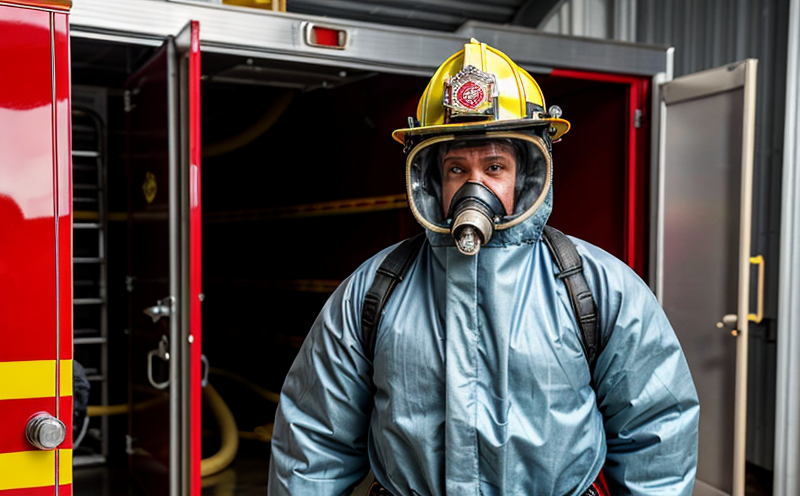Firefighter Clothing Cleaning and Decontamination Effectiveness
The fire safety testing sector focuses on ensuring that protective clothing and equipment meet stringent standards to protect firefighters in hazardous environments. One critical aspect of this is the cleaning and decontamination effectiveness of firefighter clothing, which plays a pivotal role in maintaining the integrity and performance of these garments.
Firefighter protective clothing must withstand rigorous conditions during rescue operations, including exposure to heat, smoke, and toxic substances. After use, proper cleaning and decontamination are essential to remove harmful residues and restore the garment's safety features. This process is not only a matter of comfort but also of life safety.
Our testing service evaluates the effectiveness of the cleaning and decontamination processes used for firefighter clothing. We employ advanced analytical methods to assess whether these garments retain their protective capabilities after extensive use, ensuring they continue to meet fire safety standards.
The cleaning process typically involves washing the garment according to specific protocols set by international standards such as NFPA 1971 and ISO 24093. These protocols outline the procedures for removing contaminants, including soot, chemicals, and biological agents that could compromise the integrity of the clothing.
After cleaning, our testing laboratory checks several key parameters to ensure the effectiveness of the process:
- Residual contamination levels: We measure the amount of residual soot, ash, and other contaminants left on the fabric. This ensures that the garment is not only clean but also safe for repeated use.
- Physical properties retention: Testing includes assessing whether mechanical properties such as tensile strength or flame resistance have been compromised by the cleaning process.
- Permeability and breathability: We evaluate how well the clothing retains its ability to allow air flow through the fabric, which is crucial for firefighter comfort and safety during prolonged operations in high-heat environments.
The decontamination effectiveness test involves exposing cleaned garments to controlled environmental conditions that simulate real-world usage scenarios. This allows us to determine if the cleaning process has successfully removed all hazardous materials without affecting the garment's performance characteristics.
Our testing service is designed for quality managers, compliance officers, R&D engineers, and procurement professionals who need assurance that their fire safety equipment meets stringent standards. By providing detailed reports on the effectiveness of the cleaning and decontamination processes, we help ensure that firefighters have reliable gear to rely on during critical operations.
We use state-of-the-art instrumentation and follow rigorous protocols to provide accurate and reliable test results. Our clients can trust these findings to make informed decisions about their fire safety equipment procurement and maintenance practices.
Why It Matters
The effectiveness of firefighter clothing cleaning and decontamination is critical for maintaining the safety and performance of protective gear. Proper cleaning ensures that firefighters can wear garments repeatedly without compromising their protection. This not only enhances operational efficiency but also reduces costs associated with frequent replacement of damaged or contaminated equipment.
Failure to properly clean and decontaminate fire protective clothing can lead to several risks:
- Hazardous Residue Accumulation: Contaminants such as soot, chemicals, and biological agents can accumulate on the fabric if not thoroughly cleaned. This accumulation poses a risk of re-exposure during subsequent uses.
- Reduced Performance: Over time, repeated use without proper cleaning can degrade the physical properties of the garments. This includes reduced flame resistance and lower breathability, which are essential for maintaining firefighter safety.
- Increased Risk During Rescue Operations: Firefighting operations require gear that is clean and free from contaminants to ensure optimal performance under stress. Contaminated clothing can compromise this critical requirement, leading to increased risks during rescue missions.
Beyond operational safety, proper cleaning also supports long-term sustainability by extending the life of protective equipment and minimizing waste. This aligns with broader efforts in environmental stewardship within the fire service sector.
Benefits
- Enhanced Firefighter Safety: Ensuring that cleaned clothing remains free from contaminants protects firefighters during rescue operations. This reduces the risk of re-exposure to harmful substances and maintains optimal performance.
- Cost Efficiency: By extending the life of protective equipment through effective cleaning, fire departments can reduce the need for frequent replacement, thereby optimizing operational costs.
- Compliance with Standards: Our testing service ensures that all cleaning and decontamination processes comply with relevant international standards such as NFPA 1971 and ISO 24093. This provides peace of mind to compliance officers who need to ensure regulatory adherence.
- Improved Operational Readiness: Firefighter protective clothing that is effectively cleaned and decontaminated is always ready for use, enhancing overall operational efficiency.
Environmental and Sustainability Contributions
Incorporating environmental considerations into fire safety testing not only enhances the performance of protective equipment but also supports broader sustainability goals. By ensuring that cleaning processes are effective, we help reduce waste and minimize the environmental impact associated with frequent replacement of contaminated gear.
- Reduced Waste: Effective decontamination prolongs the life cycle of fire protective clothing, reducing the amount of waste generated by frequent replacements. This aligns with sustainable practices within the fire service sector.
- Eco-friendly Cleaning Practices: Our laboratory employs eco-friendly cleaning methods that minimize environmental impact. This supports the growing trend towards more environmentally responsible operations in firefighting and rescue services.





